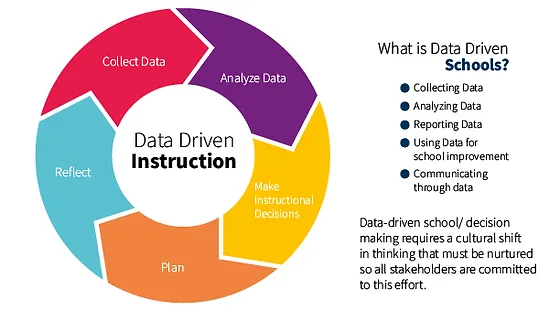The Dynamic Role of Assessment and Data in Instructional Excellence
- Stefanie Mc-E
- Nov 10, 2023
- 4 min read

Ever heard the phrase “data drives instruction”? After more than fifteen years in
education, cycling through site and district leadership changes and collaborating with educators at all stages of their careers, I can tell you, it’s a recurring theme. Data calling the shots in teaching? In the ever-evolving world of education, assessment and data play pivotal roles in shaping the learning experience. As someone knee-deep in education, my thoughts on this subject stem from an understanding of the intricate relationship between assessment, data and the dynamic process of teaching and learning.
Providing Feedback for Growth
Assessment, at its core, is a powerful tool for providing feedback. It serves as a compass, guiding both educators and learners toward a clearer understanding of strengths, weaknesses and areas for growth. As I reflect on this, I’m drawn to the idea that assessment should not merely be an endpoint but a pathway to continuous improvement. The data generated through assessments could offer valuable insights into individual and group advancement, highlighting the effectiveness of instructional methods and uncovering potential gaps in learning (Master of Arts in Educational Technology, 2023, Fall).
Evaluating Learnings: Beyond Standardization
When assessing learners, it is crucial to adopt a comprehensive viewpoint. While standardized tests provide a quantitative snapshot, the importance of ongoing formative assessments cannot be overstated. These continuous evaluations offer a comprehensive view of a student’s learning journey, uncovering not just what students know but how they acquire, transfer and apply knowledge. Recognizing the diverse ways in which students demonstrate understanding allows for more equitable and inclusive evaluation (Master of Arts in Educational Technology, 2023, Fall).
Evaluating Assessments for Validity and Reliability

The evaluation of assessments themselves is a critical but often overlooked aspect of the educational process. Assessments should align with instructional goals and measure what they claim to measure. As I explore the world of assessment design, I am aware of the need for validity and reliability. A specific assessment may provide data, but its value is dependent on its ability to accurately reflect a student’s knowledge, understanding and skills. Careful examination of assessment instruments is vital to ensure that the data they produce is not only meaningful but also capable of guiding actionable steps (Master of Arts in Educational Technology, 2023, Fall).
Data-Informed Instruction: Balancing Quantitative and Qualitative Insights

In the world of data-informed instruction, the emphasis is on utilizing assessment data to drive teaching strategies. It’s not enough to collect data for its own sake. It requires educators to interpret and apply data effectively. I am highly aware of the delicate balance between quantitative and qualitative data. While numbers provide a measurable framework, qualitative insights offer a deeper understanding of the learning experience. The combination of both allows for a more intricate and comprehensive approach to instructional planning.
Integrating Assessment Data Into Curriculum Design
The integration of assessment data into curriculum design is essential. The curriculum should be a responsive and adaptive system, in sync with the changing needs and progress of students. Regular analysis of assessment data informs necessary adjustments, ensuring the curriculum remains relevant, engaging and effective. This repetitive process can reflect a commitment to continuous improvement and align with the broader goal of fostering a culture of lifelong learning, which I desire for all my students.
The above gallery includes a few of the infographics that can be found via a simple Google search of "Assessment/Data Drives Instruction". This solidifies this is not a new theory and one that is highly discussed in education.
Conclusion
My current thoughts about assessment and data emphasize their transformative potential in education. When assessment functions as a feedback mechanism, it can provide a roadmap for improvement. The evaluation of learners, embracing diverse assessment modes, could ensure a holistic understanding. Thorough assessment evaluation is necessary for upholding the reliability and validity of the data collected.
While data-informed instruction ideally leads the way, practical challenges in the classroom such as time constraints, the expectation to cover a specific content set annually, and the diverse needs of individual learners, introduce complications. Successfully navigating through this demands a careful balance of quantitative and qualitative insights. Additionally, recognizing that curriculum development should be responsive and cyclical is essential, acknowledging that, in practice, the ideal scenario of assessment driving instruction might be hindered by factors such as pacing. As I journey through this world of education, it becomes evident that while thoughtful assessment and data utilization remain crucial, practical considerations must be handled with care in the quest of educational excellence.
References
Albany Research Center. (2023, November 10). Data-Driven Instruction Infographic [Infographic]. Knowledge Network for Innovations in Learning and Teaching. https://knilt.arcc.albany.edu/Data-Driven_Instruction
Children's Literacy Initiative. (2015, April 2). Data-Driven Instruction Infographic [Infographic]. Children's Literacy Initiative.https://cli.org/2015/04/02/what-is-data-driven-instruction/
Master of Arts in Educational Technology (2023, Fall). Course content from Unit 3: Explore critiques of standards-based reform. CEP 313: Electronic assessment for teaching and learning.
Master of Arts in Educational Technology (2023, Fall). Course content from Unit 3: Explore FROV in assessment. CEP 313: Electronic assessment for teaching and learning.
Master of Arts in Educational Technology (2023, Fall). Course content from Unit 6: Evaluating assessment. CEP 313: Electronic assessment for teaching and learning. https://d2l.msu.edu/d2l/le/content/1811793/viewContent/14520994/View
Online Learning Consortium. (2023, November 9). Assessing Across Modalities: Strengthening the Intentionality of Curricular Design [Image]. Online Learning Consortium.




















Comments